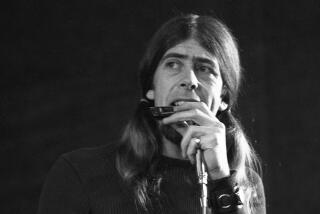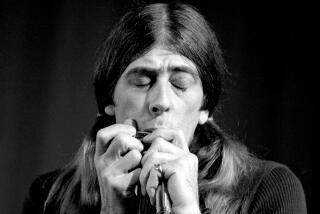John Lee Hooker; Blues Patriarch Helped Rock ânâ Roll Take Root
Blues superstar John Lee Hooker, whose deep growl and ragged guitar-picking style inspired fans and musicians for generations, died Thursday. He was 83.
Hooker, one of the few remaining links to the classic R&B; and blues sounds that served as the foundation of rock ânâ roll, died of natural causes in his sleep early Thursday at his home in Los Altos, south of San Francisco, said his longtime booking agent, Mike Kappus.
The blues patriarch from the Mississippi Delta performed on more than 100 albums in a recording career that spanned more than half a century. Inducted into the Rock and Roll Hall of Fame in 1991, he won four Grammy awards over the years and a Lifetime Achievement Award at last yearâs Grammys.
Hookerâs music remained hypnotic and raw, electrifying fans over the beat of his constantly tapping foot. Using an open-tuned guitar allowed him to combine percussive sounds and soulful notes.
He was also a gifted songwriter, creating vital music well into his 70s and 80s while representing one of the last bridges to the pre-rock era of the blues.
âJohn Lee Hooker was an artist of immeasurable importance in American pop music, someone whose menacing, lustful tales helped take rock ânâ roll from the teen celebration of the â50s to the adult urgency of the â60s,â Robert Hilburn, The Timesâ pop music critic, said Thursday night. âUnlike many of the R&B; and blues figures from the â50s, who grew stale with time, Hooker maintained his artistic command until the end, adding new levels of sophistication and nuance to his work.â
Hookerâs stylings inspired scores of artists such as the Rolling Stones, Jimi Hendrix, Bonnie Raitt, Eric Clapton, ZZ Top, Canned Heat and George Thorogood.
B.B. King, the only bluesman alive whose stature may exceed Hookerâs, said Thursday night, âI know Iâve lost a good friend, and the world has lost a great talent. He was the best at what he did.â
âThere are no superlatives to describe the profound impact John Lee left in our hearts,â said Carlos Santana, with whom Hooker recorded a duet for the Grammy-winning 1989 album âThe Healer.â âFor musicians and common people, all of us feel enormous gratitude, respect, admiration and love for his spirit. When I was a child he was the first circus I wanted to run away with.â
Born in Clarksdale, Miss., in 1917, Hooker was one of 11 children of a sharecropper who was also a Baptist minister. His musical experiences began in his fatherâs church, where he sang spirituals. His father, however, frowned on his artistic leanings, and after Hookerâs parents divorced he went to live with his mother and stepfather, a Delta blues guitarist named Will Moore.
Moore taught Hooker the guitar, and the two played together at local dances. At age 14, Hooker ran away to Memphis to perform. A few years later he moved to Cincinnati, where he sang with gospel quartets, and then to Detroit in 1943. He began playing blues clubs and bars around Detroitâs famed Hasting Street, honing a unique style that would later make him an international star. He was finally given a chance to record in 1948.
âBoogie Chillen,â in which he was accompanied only by his electric guitar and his own stomping foot, became a surprise hit for the Modern Records label, and Hookerâs first commercial success.
His distinctive rhythm patterns came to define the style widely known as boogie music. And his songs expanded the limits of the bluesâ subject matter, while also tackling sex, violence, guilt, revenge and love.
Like some other postwar blues singers who became embroiled in disagreements with their record companies, Hooker began recording for other labels under an array of pseudonyms, including Birmingham Sam and His Magic Guitar, Johnny Lee, Texas Slim and John Lee Cooker, among others.
In 1955, he began a lengthy association with Chicagoâs Vee Jay Records, where he released such R&B; hits as âBoom Boomâ and âDimples.â In the late â50s, amid a rising folk music boom, Hooker hit the folk tour circuit and began winning over a new audience, primarily young white fans.
Hooker lived in London for a time, touring Europe with John Mayallâs Bluesbreakers, featuring Clapton and Peter Green on guitars.
New albums began establishing Hookerâs name overseas, and by the early 1960s he was being cited as a major influence on rock acts in the so-called British invasion, including the Rolling Stones.
Even as popular taste veered away from the blues in the 1970s and early â80s, Hooker toured constantly and continued writing songs. The 1989 release of his album âThe Healer,â which also featured guest acts such as Los Lobos and Raitt, marked yet another Hooker revival and became one of the best-selling blues albums in history.
Raitt, in a statement released by her label, Capitol Records, said she was âdeeply saddened by the loss of my dear friend and one of the last and greatest of the original Delta bluesmen. John Leeâs power and influence in the world of rock, R&B;, jazz and blues are a legacy that will never die. Getting to know and work with him these last 30 years has truly been one of the great joys of my life.â
Guitarist John Hammond, a longtime friend who shared concert bills with Hooker and learned of his death moments before going on stage Thursday night at New Yorkâs Underground Village, said, âI feel so honored to have known him. . . . Iâm definitely going to announce it and dedicate the set to him.â
While Hooker remained on the road constantly nearly to the end, he enjoyed a quiet suburban life when he could, maintaining a fleet of luxury cars. An avid baseball fan, Hooker used to keep multiple radio receivers tuned to different stations to monitor as many games as possible.
âI never, ever imagined Iâd have a career last this long . . . but here I am,â Hooker told The Times in 1998. âIf I stopped playing the blues, Iâd be miserable. Iâve been given a gift from the good Lord. . . . I think doing what I do is just in my blood.â
A decade earlier, before the release of âThe Healer,â Hooker told a Times interviewer that he sometimes wore sunglasses when he played to prevent fans from seeing him cry during his sets.
âYou know, I may not be too good at writing things down, but when it comes to creating a song from hereâ--pointing to his heart--âand hereâ--then to his head--ânobody can beat me.â
*
Times staff writer Mike Boehm contributed to this story.
More to Read
The biggest entertainment stories
Get our big stories about Hollywood, film, television, music, arts, culture and more right in your inbox as soon as they publish.
You may occasionally receive promotional content from the Los Angeles Times.










